一、题目描述
本题要求在一个数组中实现两个堆栈。
函数接口定义:
Stack CreateStack( int MaxSize );
bool Push( Stack S, ElementType X, int Tag );
ElementType Pop( Stack S, int Tag );
其中Tag是堆栈编号,取1或2;MaxSize堆栈数组的规模;Stack结构定义如下:
typedef int Position;
struct SNode {
ElementType *Data;
Position Top1, Top2;
int MaxSize;
};
typedef struct SNode *Stack;
注意:如果堆栈已满,Push函数必须输出“Stack Full”并且返回false;如果某堆栈是空的,则Pop函数必须输出“Stack Tag Empty”(其中Tag是该堆栈的编号),并且返回ERROR。
裁判测试程序样例:
#include <stdio.h>
#include <stdlib.h>
#define ERROR 1e8
typedef int ElementType;
typedef enum { push, pop, end } Operation;
typedef enum { false, true } bool;
typedef int Position;
struct SNode {
ElementType *Data;
Position Top1, Top2;
int MaxSize;
};
typedef struct SNode *Stack;
Stack CreateStack( int MaxSize );
bool Push( Stack S, ElementType X, int Tag );
ElementType Pop( Stack S, int Tag );
Operation GetOp(); /* details omitted */
void PrintStack( Stack S, int Tag ); /* details omitted */
int main()
{
int N, Tag, X;
Stack S;
int done = 0;
scanf("%d", &N);
S = CreateStack(N);
while ( !done ) {
switch( GetOp() ) {
case push:
scanf("%d %d", &Tag, &X);
if (!Push(S, X, Tag)) printf("Stack %d is Full!\n", Tag);
break;
case pop:
scanf("%d", &Tag);
X = Pop(S, Tag);
if ( X==ERROR ) printf("Stack %d is Empty!\n", Tag);
break;
case end:
PrintStack(S, 1);
PrintStack(S, 2);
done = 1;
break;
}
}
return 0;
}
/* 你的代码将被嵌在这里 */
二、解题思路
一个数组实现双栈,其实就是数组的0下标处作为栈1的第一个位置,数组的MaxSize - 1下标处作为栈2的第一个位置
那Stack->Top1的含义是什么呢,它的含义是当前栈的栈顶在哪个下标处。考虑初始情况,也就是栈内一个元素都没有的情况,那么此时Stack->Top1应该为-1而不是0。Stack->Top2与之同理,起始时应该为MaxSize而不是MaxSize - 1。
在CreateStack的时候,千万不要忘记申请内存。第一次为结构体指针申请,第二次为结构体的指针成员申请。
三、解题代码
Stack CreateStack(int MaxSize) {
struct SNode* tmp = (struct SNode*)malloc(sizeof(struct SNode));
if(!tmp) exit(0);
tmp->MaxSize = MaxSize;
tmp->Data = (ElementType*)malloc(sizeof(ElementType) * MaxSize);
if(!tmp->Data) exit(0);
tmp->Top1 = -1;
tmp->Top2 = MaxSize;
return tmp;
}
bool Push(Stack S, ElementType X, int Tag){
if(Tag == 1){
if(S->Top1 + 1 == S->Top2){
printf("Stack Full\n");
return false;
}
else S->Data[++S->Top1] = X;
}
else if(Tag == 2){
if(S->Top2 - 1 == S->Top1){
printf("Stack Full\n");
return false;
}
else S->Data[--S->Top2] = X;
}
else return false;
return true;
}
ElementType Pop(Stack S, int Tag){
ElementType ret;
if(Tag == 1){
if(S->Top1 == -1){
printf("Stack %d Empty\n", Tag);
return ERROR;
}
else ret = S->Data[S->Top1--];
}
else if(Tag == 2){
if(S->Top2 == S->MaxSize){
printf("Stack %d Empty\n", Tag);
return ERROR;
}
else ret = S->Data[S->Top2++];
}
return ret;
}
四、运行结果
